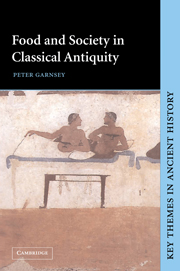Book contents
- Frontmatter
- Contents
- List of illustrations
- Acknowledgements
- Abbreviations
- Preface
- Introduction: Food, substance and symbol
- 1 Diet
- 2 Food and the economy
- 3 Food crisis
- 4 Malnutrition
- 5 Otherness
- 6 Forbidden foods
- 7 Food and the family
- 8 Haves and havenots
- 9 You are with whom you eat
- Conclusion: Choice and necessity
- Bibliographical essay
- Bibliography
- Index
Introduction: Food, substance and symbol
Published online by Cambridge University Press: 05 June 2012
- Frontmatter
- Contents
- List of illustrations
- Acknowledgements
- Abbreviations
- Preface
- Introduction: Food, substance and symbol
- 1 Diet
- 2 Food and the economy
- 3 Food crisis
- 4 Malnutrition
- 5 Otherness
- 6 Forbidden foods
- 7 Food and the family
- 8 Haves and havenots
- 9 You are with whom you eat
- Conclusion: Choice and necessity
- Bibliographical essay
- Bibliography
- Index
Summary
PRELIMINARIES
There is no god like one's stomach: we must sacrifice to it every day.
(From ‘Hunger’, a Yoruba song)I hate the belly: it dogs you shamelessly,
making you remember it willy nilly
in the midst of stress, in the midst of sorrow of heart.
(Homer, Od. 7.216–18; transl. A. J. Bowen)Food comes first. No food, no life. In myth, the satisfying of this primary need was a struggle and a burden. The sin of Adam (issuing from the gut rather than the loins) condemned humanity, the flower of creation, to getting its food the hard way, through tilling the soil. Prometheus, Adam's counterpart in Greek myth, through his act of stealing fire from heaven, brought upon the human race the harsh necessity of agricultural labour, without which the seed, sunk in the earth by a vengeful Zeus, could not be converted into an edible plant. Agriculture was a punishment imposed upon mankind, and a diet of cereals a drastic comedown from the divine menu of nectar and ambrosia, or from the free produce of the Garden of Eden.
In antiquity, as in all pre-industrial societies, most people were of necessity engaged in food-production. In the Mediterranean environment this was often a hazardous enterprise carried on in hostile surroundings. The grimness of the terrain worked by the people of Palestine is reflected in the prominence of miracles of feeding in the New Testament, and in the Old Testament prophets' dreams of a Promised Land of abundant food and drink (Is. 35:1; Ezek. 47:7–12).
- Type
- Chapter
- Information
- Food and Society in Classical Antiquity , pp. 1 - 11Publisher: Cambridge University PressPrint publication year: 1999



